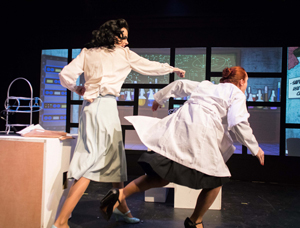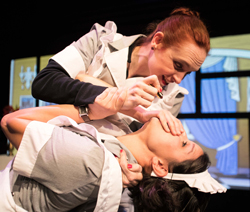
It's easy to walk away from The Invisible Scarlet O'Neil proclaiming the star of the show to be its special effects. When your heroine is a scientist's daughter turned social reformer after a laboratory mishap endows her with the power of—you guessed it—invisibility, saving the world from enemy aggression is a stroll through the funny-pages compared to translating print-graphic narrative to live-action performance.
The technical expertise on display in this Babes With Blades Theatre Company production showcases the faux-comic book projections of G. Max Maxin IV, whose caption boxes, thought balloons and onomatopoeic inserts zip expository information past us in mere seconds. Likewise contributing to the wizardry are the smart career-girl suits tailored by costumer Kimberly G. Morris with electroluminescent wire in the hems and lapels (allowing us to "see" our damsel of derring-do in her diaphanous state), along with adversaries alone onstage trading punches and grapples with empty air under the instruction of fight designer Libby Beyreis.
From a literary standpoint, the major challenge lies in reconfiguring an episodic adventure to the streamlined dimensions of a single story arc. Barbara Lhota's adaptation begins with a prologue acquainting us with the circumstances of our title character's extraordinary capabilities, then shifts its time frame to introduce our crusader five years later, employed incognito as a cub reporter for the City News—a Chicago publication, of course.
The resurrection in 2017 of the comic strip making its debut on June 3, 1940—a full year before the arrival of the immigrant princess born of Greek myth we know today as Wonder Woman—is not simply a pretext for showy stage legerdemain, however, nor is it a gratuitous exercise in nostalgia.
"Russell Stamm's Scarlet O'Neil ran in the Chicago Times from 1940 to 1956, even after the paper merged with the Sun to become the Sun-Times," Lhota reminds us, "The women of the 1940s were occupied in formerly male-dominated industrial jobs, but following the war, they were pushed out by men returning from military duty and a social environment increasingly unsupportive of women in the workplace—in effect, rendered invisible again. So Scarlet and her fellow journalists must fight not only for justice, but writing credit as well."
The author of The Double and The 180 Degree Rule confesses to an affinity for the rat-a-tat repartee in vogue during this era. "When Elyse Dawson and Kathrynne Wolf asked me to adapt Scarlet O'Neil as the first commissioned play of the Babes With Blades' Twentieth Anniversary season, naturally, I accepted."
 The itinerant theater company is currently quartered at The Factory on Howard Street. While acknowledging the difficulties of performing on a thrust stage surrounded by audience on three sides, both Lhota and director Leigh Barrett concur in their favorable appraisal of the storefront's intimate ambience.
The itinerant theater company is currently quartered at The Factory on Howard Street. While acknowledging the difficulties of performing on a thrust stage surrounded by audience on three sides, both Lhota and director Leigh Barrett concur in their favorable appraisal of the storefront's intimate ambience.
"Not only is the audience close to the action," says Barrett, "but they can see each other across the room and feed off each other's reactions, which in turn intensifies the energy levels."
"The goal is to keep the play moving, physically and dramatically, while still ascertaining that that the audience follows every word." Lhota insists, "Leigh often tells actors to 'dance' around, or fidget with the props—something actors usually are warned not to do—so that they can face as many sides as possible." She sighs, "For all the slapstick and tech effects, though, the lesson that we want the audience to take home is that our very peculiarities—that is, our individual superpowers—can be our greatest strength."
The Invisible Scarlet O'Neil runs at The Factory through October 14.
Mary Shen Barnidge
Contributing Writer

 Follow Us On Twitter
Follow Us On Twitter